Blair's work
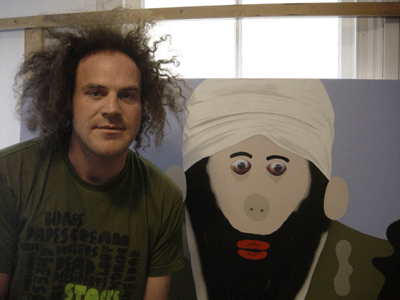
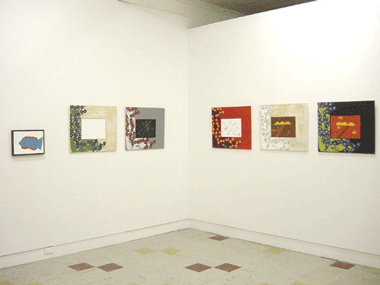
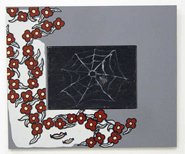
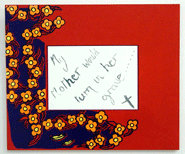
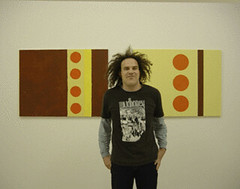
Thanks mum, paintings by Anne Kearney. Blair Trethowan
Blair asks his Mum to do paintings for him.
There are a few things that come to mind. The first is Pedro Almodovar’s film All About My Mother. In it Esteban asks his mother, Manuela, if she would prostitute herself to protect him. It’s hypothetical, of course, but Manuela replies that she has already done almost everything a mother could do for him. The movie unfolds and Esteban dies. The hypothesis – perhaps Manuela did do all that she could... except tell Esteban about his father, who happens to be a
HIV-positive transsexual prostitute.
Secondly – a longer, personal anecdote:
My mother always hated art, primarily because she thought it was about being a good drawer and she wasn’t. She thought that she couldn’t understand it – that it all went above her head. I suppose I kind of used to think the same thing.
Anyway, my mother dies, and you have to clean a whole lot of shit up. Which is hard ‘cause you find things that you didn’t know about. And then you have to throw stuff out, which is harder because you’ve already lost the person they belong to and throwing their possessions out is like negating their existence – even when you know, theoretically, this isn’t true – that you have memory and all of that.
Anyway, I kept this book that mum made.
She was sick for a long time and watched a lot of TV. The lounge-room was filled with videocassettes of the programs she couldn’t watch when broadcast because the show was on at 4.30 in the morning or at the same time as another. I went around there on Sunday’s - we watched telly and instead of talking about the obvious, we got on to doing crosswords together. We both liked trivia and quizzes and, probably more so, we liked competing against each
other (not that this was ever said). Like the obsessive compulsive she was, crosswords came to occupy much of her time.
The book – it has a turquoise hard cover and is spiral bound in black, the pages within are lined... basically its your standard A5 notebook that you can buy from Officeworks for approximately 4 bucks. Each page in the book is filled with information – a page per TV show, about 60 in all. By no means is it a comprehensive guide to pop culture, but it’s reasonably extensive. For each TV show the director, producer, shooting location and casts are listed. There is information crossed out and written over, various pens have been used and her handwriting changes in size – it was added to on a regular basis. I suppose the book is like a self-compiled dictionary or encyclopedia. The order was determined as the information came
to hand, not alphabetically or chronologically. Mum had no access to the Internet or reference books. Basically the book sat beside her on the couch and as she read something, watched something or found the answers to last week’s crossword; the information was systematically entered into the book. Occasionally, when I was visiting, she would quiz me and my answers would be added. But the book, which had kind of started off as ours, became hers. The pages are well worn and although it seems there is no apparent order, she knew where all the answers were when needed. Inside the book there are also snippets – hand-written notes, clippings from magazines and newspapers with information underlined, waiting to be catalogued.
I had always wanted to do a series of drawings based on this book – like an illustrated dictionary I guess – not as a kind of tribute but more like my addition to the information, the part I could’ve played I suppose – kind of daggy and sentimental (I know). I haven’t though, and doubt that I will. The value in this book, I suppose, is that it is like evidence of an experience. As personal as this is, somehow it transgresses just my own experience. I’ve shown it to other people (much to her dislike – she used to say to me, already embarrassed “I bet you show this to your friends”), and they see a value in it as well – maybe this is because they know me – I like thinking that it’s not. It’s funny – the book is filled with errors, it’s not perfect, it doesn’t tell you things you really need to know or information you can’t find out somewhere
else, so in a way its kind of wrong and in the greater scheme of things it’s not a significant artwork. But it feels like one.
Just before she died, I was trying to do a crossword with her to keep her awake, I was asking her the questions and filling in the blanks, she looked up at me from her dozy state and said, “Are you stupid or something?”
Maybe I am.
Thirdly – the book Vernon God Little, written by Peter Findlay under his nickname of DBC Pierre. Vernon has been wrongly accused of a high school massacre. His mother, Doris, refuses to mention and acknowledge that he has been arrested for murder at any point during the novel – the hypothesis: families don’t to talk about shit – it’s all somehow encoded in Doris’ persistent questioning – “Are you eating well?” “What did you have for dinner?”
Lastly – Sophia Coppola’s Lost in Translation. Bob Harris whispers something into Charlotte’s ear. In the tender gesture, the audience is given the power to make up and interpret the meaning of the unheard words.
“Surrounded by voices of dubious authority we should practice being blind and silent’.” Elizabeth Newman quoted it from Eden Liddelow and sent it to Geoff, Geoff sent it to Blair, and then Blair sent it to me. Perhaps Liz is right. But... perhaps... we shouldn’t be too blind and too silent.
Maybe.
——There are a few things that come to mind. The first is Pedro Almodovar’s film All About My Mother. In it Esteban asks his mother, Manuela, if she would prostitute herself to protect him. It’s hypothetical, of course, but Manuela replies that she has already done almost everything a mother could do for him. The movie unfolds and Esteban dies. The hypothesis – perhaps Manuela did do all that she could... except tell Esteban about his father, who happens to be a
HIV-positive transsexual prostitute.
Secondly – a longer, personal anecdote:
My mother always hated art, primarily because she thought it was about being a good drawer and she wasn’t. She thought that she couldn’t understand it – that it all went above her head. I suppose I kind of used to think the same thing.
Anyway, my mother dies, and you have to clean a whole lot of shit up. Which is hard ‘cause you find things that you didn’t know about. And then you have to throw stuff out, which is harder because you’ve already lost the person they belong to and throwing their possessions out is like negating their existence – even when you know, theoretically, this isn’t true – that you have memory and all of that.
Anyway, I kept this book that mum made.
She was sick for a long time and watched a lot of TV. The lounge-room was filled with videocassettes of the programs she couldn’t watch when broadcast because the show was on at 4.30 in the morning or at the same time as another. I went around there on Sunday’s - we watched telly and instead of talking about the obvious, we got on to doing crosswords together. We both liked trivia and quizzes and, probably more so, we liked competing against each
other (not that this was ever said). Like the obsessive compulsive she was, crosswords came to occupy much of her time.
The book – it has a turquoise hard cover and is spiral bound in black, the pages within are lined... basically its your standard A5 notebook that you can buy from Officeworks for approximately 4 bucks. Each page in the book is filled with information – a page per TV show, about 60 in all. By no means is it a comprehensive guide to pop culture, but it’s reasonably extensive. For each TV show the director, producer, shooting location and casts are listed. There is information crossed out and written over, various pens have been used and her handwriting changes in size – it was added to on a regular basis. I suppose the book is like a self-compiled dictionary or encyclopedia. The order was determined as the information came
to hand, not alphabetically or chronologically. Mum had no access to the Internet or reference books. Basically the book sat beside her on the couch and as she read something, watched something or found the answers to last week’s crossword; the information was systematically entered into the book. Occasionally, when I was visiting, she would quiz me and my answers would be added. But the book, which had kind of started off as ours, became hers. The pages are well worn and although it seems there is no apparent order, she knew where all the answers were when needed. Inside the book there are also snippets – hand-written notes, clippings from magazines and newspapers with information underlined, waiting to be catalogued.
I had always wanted to do a series of drawings based on this book – like an illustrated dictionary I guess – not as a kind of tribute but more like my addition to the information, the part I could’ve played I suppose – kind of daggy and sentimental (I know). I haven’t though, and doubt that I will. The value in this book, I suppose, is that it is like evidence of an experience. As personal as this is, somehow it transgresses just my own experience. I’ve shown it to other people (much to her dislike – she used to say to me, already embarrassed “I bet you show this to your friends”), and they see a value in it as well – maybe this is because they know me – I like thinking that it’s not. It’s funny – the book is filled with errors, it’s not perfect, it doesn’t tell you things you really need to know or information you can’t find out somewhere
else, so in a way its kind of wrong and in the greater scheme of things it’s not a significant artwork. But it feels like one.
Just before she died, I was trying to do a crossword with her to keep her awake, I was asking her the questions and filling in the blanks, she looked up at me from her dozy state and said, “Are you stupid or something?”
Maybe I am.
Thirdly – the book Vernon God Little, written by Peter Findlay under his nickname of DBC Pierre. Vernon has been wrongly accused of a high school massacre. His mother, Doris, refuses to mention and acknowledge that he has been arrested for murder at any point during the novel – the hypothesis: families don’t to talk about shit – it’s all somehow encoded in Doris’ persistent questioning – “Are you eating well?” “What did you have for dinner?”
Lastly – Sophia Coppola’s Lost in Translation. Bob Harris whispers something into Charlotte’s ear. In the tender gesture, the audience is given the power to make up and interpret the meaning of the unheard words.
“Surrounded by voices of dubious authority we should practice being blind and silent’.” Elizabeth Newman quoted it from Eden Liddelow and sent it to Geoff, Geoff sent it to Blair, and then Blair sent it to me. Perhaps Liz is right. But... perhaps... we shouldn’t be too blind and too silent.
Maybe.
Lisa Radford
(Lisa wrote this text while she was living in Kyoto during 2004. It was published in Natural Selection, Issue 2: 2004)
www.naturalselection.org.nz
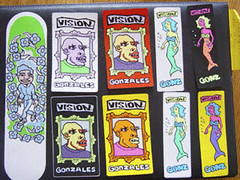
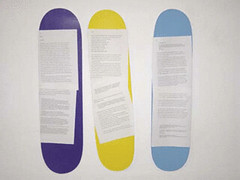

1 Comments:
LOVE who you are. Who are you?
We had a suicide bomber in New Zealand in the 1980s. He blew up the Wanganui Computer Centre, the place where the New Zealand police records were kept, in protest. Neil Roberts was his name. Just prior to this he spray painted on the wall opposite the building ‘we have maintained a silence closely resembling stupidity’. He had a tattoo saying ‘this punk won’t see 23’. He didn’t. He had something to say, and he said it. In many facets of our existence there is silence. People are scared to speak. When do we have a voice?
Love 2005 is a suite of five collages on bark. On each bark Blair Trethowan presents a snapshot of his experience in the world - a moment of reflection - a panoptic mirror. In his discussion on dialectics, Robert Smithson writes “art critics and artists have for a long time considered the shell without the context of the ocean”. In Love 2005 the ocean becomes a complex sea of society, politics, culture on which floats barks and images as shells, empty, waiting to sink from atop of its viscous surface. Although this might sound rather cosmic, there is good reason.
Blair was conceived in the early 1970s, and although this might be plainly obvious, this it is where the work begins. The barks that Blair uses in this work follow a loose trajectory of his existence - from conception to adulthood. In doing so, he questions the contexts he has moved through, a journey in which he has noticed gaps. These gaps become spaces in which to pose questions.
Each of the five works in Love 2005 unravels a particular story or moment in Blair’s life. Love 2005 draws on a pattern gleaned from a craft art book published the year of his conception. In using this book as source material the artist considers the cultural climate in which his parents were beginning a family. The design’s soft kitsch-ness provides a point of reference, a nod to the past. The 1970s cliché of free love is pivotal – how free is love?
'Fuck in the back seat' has a sense of freedom, or is that free love. The work stems from Blair’s encounter with a kid in a skate park who had covered his bike with stickers that said ‘fuck in the back seat’, which were altered with a Texta from the intended meaning - ‘buckle up in the back seat’. The freedom here is in the choice. The boy made a choice about how he would be in the world, and he made some changes to his possessions that reflected that. This shift from safety message to an expression of disregard can be seen as a test site, an act of defiance against prescribed ways of being in the world.
How, why, and when can we act? 'Led Zepplin Mutlu' traces an act of innocence made myth, by Melbourne artist Mutlu Cerkez who as a child apparently painted Pink Floyd’s dark side of the moon album cover on the wall of his parents kitchen. Blair emulated this by reproducing a large mural of a Led Zepplin cover on the wall of his parents house (as an adult, as an artist), on top of an existing painting of pelicans. As opposed to Mutlu’s apparently disengaged act, Blair made a conscious decision to politicise this act as a sign of admiration for Mutlu’s vision. As a pop cultural symbol the Zepplin is universal, it’s commodified.
Jokes are funny when we understand the context. And they are supposed to be funny. 'The Queen’s Teeth' is a kind of joke. It’s something i imagine someone discovered while drinking a beer alone at the pub. When a five dollar note is folded, the Queen’s pearl necklace becomes teeth, her neck a penis. The folding carries the notion that sex and power are inextricably bound. I’m not sure if that was considered at the point of its discovery. However, resting on the surface of the bark the note takes on an oblique reference to colonisation in Australia. The joke’s not funny anymore. Or is it?
'Sweat Skulls and Love Hearts' reflects a physical state the artist experiences when he skates. His body, in a seemingly cathartic response, produces sweat marks on his t-shirt that form an uncanny set of signifiers – the skull and the heart. In the context of these works, these signifiers carry weighty reference. The head and the heart become symbols for thinking and feeling, they are the central reference of this investigation – how do we think? And how do we feel? Artist Lee Ralph is a skateboarder. In a work installed at Uplands Gallery, Blair asked the artist about the meaning of the Tiki figures and other iconography, Lee Ralph responded saying that he didn’t quite know what they were, or where they came from, it was in his blood.
Our place in the present is defined by history. Frederick Jameson suggests that capitalism creates a historical amnesia, where we are destined to live in the perpetual present. It’s true, we have lost sight of the past and in many ways, as we amble around in a collective confusion without a sense of the ways history informs us in the present. Within the structures of capitalism looking back becomes a delay. We are encouraged to keep our eyes firmly poised on moving into the future. Maori believe that you must walk backwards into the future, so as to always have our ancestors before you. The past is something to look forward to and the future’s always behind your back. I am interested in this because it defines time and experience as non-linier, as critical to our make-up. In a sense Blair is trying to unpick the structures that suggest what is right to say, and when to say it. The cultural context of Blair’s use of bark, and the presentation of more personal experiences in his life, creates two polar elements with a seemingly large divide in between. Within this divide there is a silence in which he raises questions. In this silence, we are encouraged to consider, or to speak.
In 'Skate Sequence', Blair performs a skate trick. Stitched to his jacket is a patch of Jon Campbell’s Yeah flag. The flag, recently been championed by A Constructed World as the new Australian flag through a petition site, represents a site of resistance against the current Australian flag, and what it represents. The trick that Blair is performing seems experimental, yet has a certain confidence in its opening up to failure. I guess this is the attraction in skating. Sometimes you win, sometimes you loose, but it’s about taking risks.
Art is embedded in a history of appropriation - everything is ripe for the picking. Materials become signifiers on top of already loaded signifiers. Here barks frame an uneasy discussion about colonisation in which the work embarks on a critical unravelling of thinking about place - or at least act as a springboard for these considerations. While it could be easy to read these works as an exercise in dalliance, they are not purely diaristic – embedded in these works is a sense of agency. Love 2005 reminds us of potent political issues that we face in the course of our existence – like how, why and when we deal with the ‘bigger issues’ like colonisation. Is there a right time to ask these questions? Currently, these questions are not being asked, which is why Blair attends to them. Art has always defended the impossibility of answering the big questions. It is this ability, to be both engaged and reflective, that makes art critical.
It seems in looking back that Blair is mapping out a way forward. These moments, and fleeting experiences are embodied as objects for reflection amidst a lingering question of how, through self-reflection and definition, we can engage our attention towards a bigger picture of our situation in the world. Hal Foster describes art as the ‘running room’ between life and experience, a space for critical thinking. Love 2005 has all the markings of the running room. The work creates a space in which questions are foregrounded, room for critical investigation. If art exists in this space, is it then free to speak as if it is both inside and outside of culture and society? I think it can.
Danae Mossman, September 2005
Catalogue essay for Blair's 'Love 2005' Studio 12 exhibition at Gertrude, September 2005
Post a Comment
<< Home